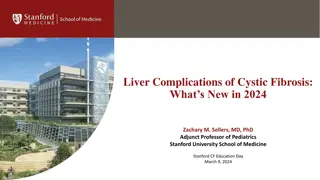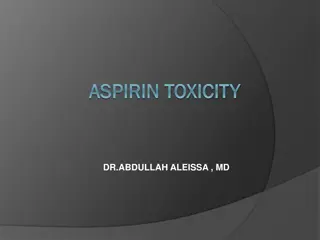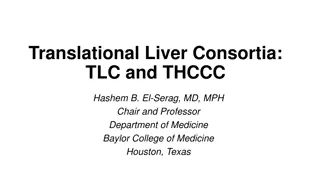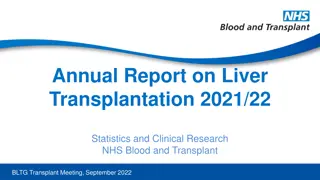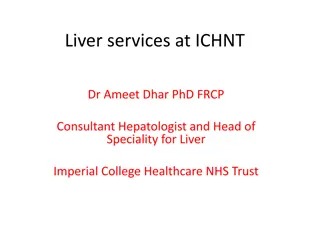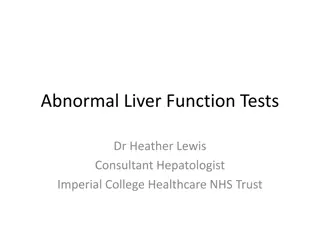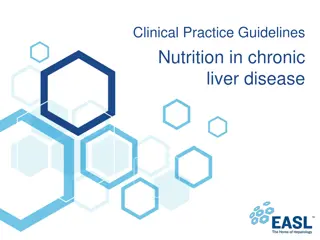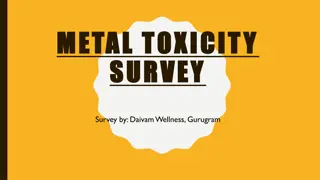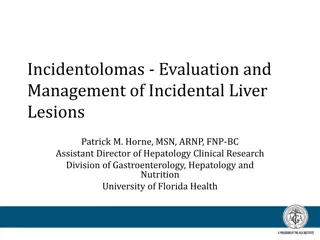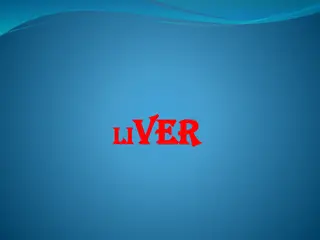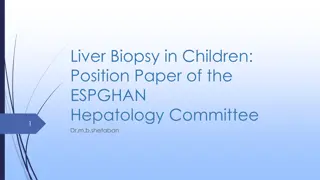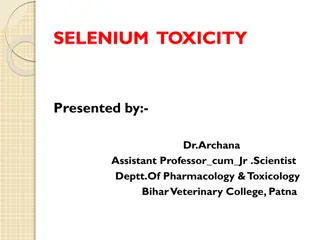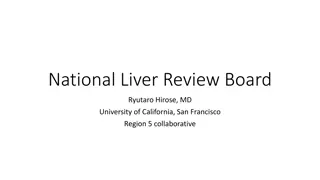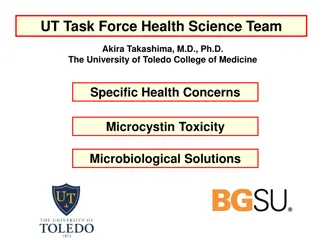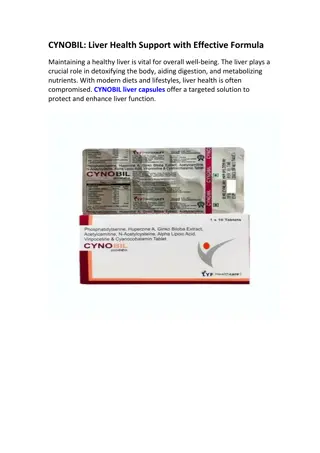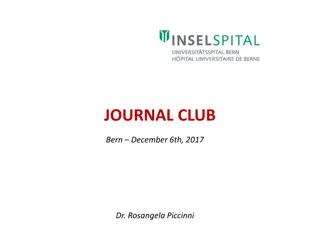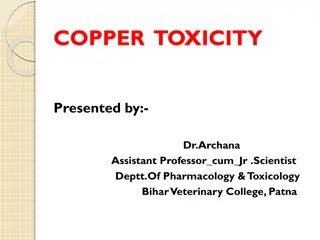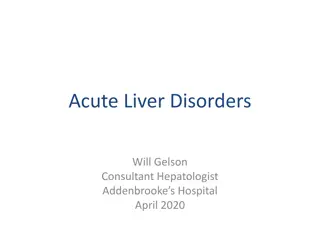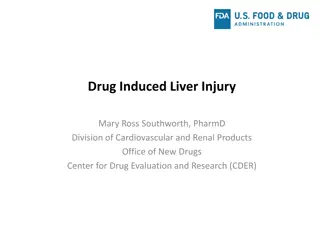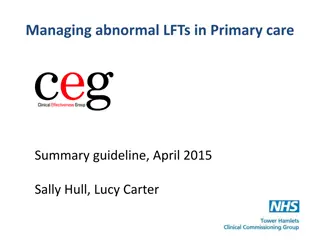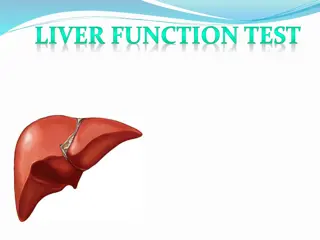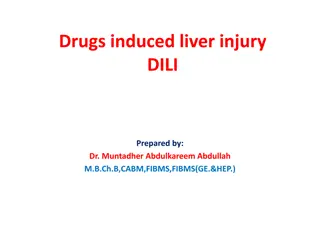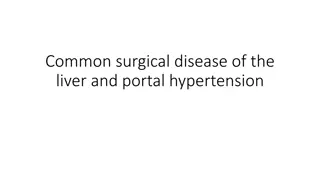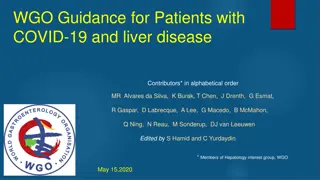Understanding Liver Function Tests in Cholestatic Injury
Cholestatic liver disease affects Alkaline Phosphatase (ALP) and bilirubin levels, indicating bile duct damage. GGT and 5'-Nucleotidase help differentiate hepatobiliary vs. bone origin of ALP elevation. ALP is produced by bile duct epithelium and can be normal in acute biliary obstruction. GGT and N
1 views • 33 slides
Understanding Steatotic Liver Disease: Importance, Epidemiology, and Pathology
Steatotic liver disease, including metabolic dysfunction associated steatohepatitis (MASLD) and metabolic associated alcoholic liver disease (MALD), is a common cause of liver test abnormalities in the United States. Risk factors such as obesity and metabolic syndrome can lead to advanced fibrosis a
2 views • 44 slides
Liver Transplant in India for treatment
Liver is the largest gland in our body, and an important metabolic organ which carries out many essential biological functions. The liver is a wedge-shaped, reddish-brown in color with two lobes of different size and shape. The approximate weight of a human liver is 1.5 kilograms. It is in the upper
5 views • 2 slides
Understanding Liver Complications in Cystic Fibrosis: Latest Insights for 2024
Liver complications in cystic fibrosis (CF) have gained importance due to CFTR modulators impacting liver health. This presentation by Dr. Zachary M. Sellers delves into new definitions for CF liver disease, CFF recommendations for screening, management, and treatment of hepatobiliary issues in CF.
0 views • 17 slides
Best Liver transplant hospitals in India
Best Liver Transplant Hospitals in India\nThe liver is a vital organ that performs important functions in the human body, including detoxification, metabolism, and the production of essential proteins. However, certain conditions such as liver failure, cirrhosis, or liver cancer may necessitate a li
0 views • 2 slides
Understanding Acetaminophen Poisoning: Mechanism, Toxicity, and Treatment
Acetaminophen poisoning occurs when the body is overwhelmed by high doses of the drug, leading to liver toxicity and potentially fatal consequences. The mechanism of toxicity involves the depletion of glutathione and the formation of a harmful metabolite, N-acetyl-para-benzoquinoneimine (NAPQI). Con
2 views • 9 slides
Understanding Aspirin Toxicity: Overview and Management
Aspirin toxicity, though decreasing in incidence, can still result in severe consequences such as metabolic acidosis, seizure, and even death. This condition is often underestimated due to lack of familiarity with its clinical presentation. Treatment focuses on maintaining salicylate in the ionized
0 views • 22 slides
Understanding Toxicology: Dose-Response and Toxicity Assessment
The study of toxicology involves understanding dose-response relationships, lethal concentrations, tolerance limits, toxicity curves, and factors influencing toxicity. Dose, response, acute toxicity, chronic toxicity, LD50, and ED50 are key concepts in toxicology that help assess the effects of chem
2 views • 24 slides
Histological Structure of Liver and Spleen: Key Features and Functions
In this informative content, the histological structures of the liver and spleen are explored in detail. Key components such as hepatocytes, sinusoids, bile canaliculi, and the spaces of Disse in the liver, and the white pulp and red pulp in the spleen are highlighted. The classic liver lobule, cent
2 views • 10 slides
Translational Liver Cancer Research Initiatives
Translational Liver Consortia (TLC) and the Translational Hepatocellular Carcinoma Consortium (THCCC) led by Dr. Hashem B. El-Serag are focused on advancing research for early detection of liver cancer. The main objectives include patient stratification for liver cancer risk, surveillance in cirrhos
0 views • 25 slides
Urea Biosynthesis and the Krebs-Henseleit Cycle in the Liver
Urea is synthesized in the liver through a series of enzymatic steps known as the urea cycle or Krebs-Henseleit cycle. This process involves converting toxic ammonia into urea, a less toxic and water-soluble compound that can be easily excreted in urine. The liver plays a crucial role in urea biosyn
1 views • 20 slides
Liver Transplantation Report 2021/22 Statistics & Research Findings
The Annual Report on Liver Transplantation 2021/22 presents detailed statistics and clinical research findings from the NHS Blood and Transplant BLTG Transplant Meeting in September 2022. The report covers an overview, transplant list, donor and organ supply, transplant activity, and outcomes. It hi
1 views • 45 slides
Liver Services at Imperial College Healthcare NHS Trust
The liver services at Imperial College Healthcare NHS Trust, led by Dr. Ameet Dhar, provide a comprehensive range of services for patients with liver conditions. With over 2000 new patients seen annually, services include inpatient care, specialist clinics, outreach programs, and referral pathways.
0 views • 14 slides
Understanding Abnormal Liver Function Tests: Insights from Dr. Heather Lewis, Consultant Hepatologist
Abnormal liver function tests can be a perplexing issue with various underlying causes. Dr. Heather Lewis, a renowned Consultant Hepatologist at Imperial College Healthcare NHS Trust, sheds light on the significance of liver function tests, liver enzymes, and blood markers in diagnosing liver condit
0 views • 21 slides
Clinical Practice Guidelines: Nutrition in Chronic Liver Disease Overview
These slides provide a comprehensive overview of the EASL clinical practice guidelines on nutrition in chronic liver disease. The guidelines were first presented at the International Liver Congress 2018 and will soon be published in the Journal of Hepatology. The content covers methods of grading ev
6 views • 37 slides
Understanding Metal Toxicity: Risks, Detection, and Impact on Health
Metal toxicity is a growing concern affecting many individuals today, with 41% of Delhi & NCR population testing positive for severe heavy metal toxicity. This survey by Daivam Wellness aims to create awareness about the dangers of metal toxicity and its impact on health, including diseases such as
0 views • 7 slides
Evaluation and Management of Incidental Liver Lesions
Understanding the natural history, evaluation, and management of benign liver lesions is crucial for diagnosing incidental liver findings. Common benign liver lesions include hepatic hemangioma, focal nodular hyperplasia, hepatic adenoma, and hepatic cyst. Differential diagnosis plays a key role in
0 views • 37 slides
Insights into Liver Anatomy, Function, and Imaging Studies
Delve into a comprehensive overview of the liver's anatomy, including ligaments, blood supply, and structure in the hilum. Explore the vital functions performed by the liver, such as maintaining body temperature, synthesizing clotting factors, and drug metabolism. Discover liver function tests and t
3 views • 22 slides
Evolution of Liver Biopsy in Children: ESPGHAN Position Paper
Liver biopsy plays a crucial role in diagnosing, staging, and prognostic evaluation of liver diseases in children. Indications for liver biopsy include diagnostic, prognostic, and monitoring purposes. Specific scenarios like neonatal cholestasis and progressive familial intrahepatic cholestasis requ
2 views • 47 slides
Understanding Liver Detoxification and Harmony in Traditional Chinese Medicine
The liver plays a crucial role in detoxification and maintaining harmony in the body according to Traditional Chinese Medicine (TCM). Issues like liver disharmony can lead to various symptoms and health conditions. TCM emphasizes the importance of supporting liver function for overall well-being by
0 views • 21 slides
NGM282 in NASH: Phase 2 Study on Liver Fat Reduction and Histology Changes
A phase 2 study on NGM282 in NASH patients showed a significant decrease in liver fat content, meeting the primary endpoint. Exploratory findings also indicated potential improvements in liver histology. The treatment involved NGM282 at 3 mg QD, with additional rosuvastatin if needed. Promising resu
0 views • 11 slides
Understanding Abnormal Liver Function Tests: Acute vs. Chronic Approach
Comprehensive discussion on assessing patients with abnormal liver test results, focusing on distinguishing between acute and chronic liver conditions. Covers diagnostic workup, patient cases, and differential diagnosis, emphasizing the importance of patient history, physical examination, and key di
0 views • 16 slides
Understanding Selenium Toxicity in Animals: Sources, Mechanism, and Clinical Signs
Selenium toxicity in animals can occur through various sources such as selenium-containing plants. The toxicokinetics involve absorption from the gut and distribution to different body parts. The mechanism of toxicity is linked to the incorporation of selenium in amino acids and proteins, leading to
0 views • 10 slides
Pharmacotherapy for Non-Alcoholic Fatty Liver Disease: An Updated Review by Anita Eftekharzadeh
This comprehensive review discusses the pharmacotherapy options for Non-Alcoholic Fatty Liver Disease (NAFLD), covering topics such as sub-classification of NAFLD, proposed risk stratification, non-invasive measures for assessing liver fibrosis, and the NAFLD Activity Score (NAS). Anita Eftekharzade
0 views • 44 slides
National Liver Review Board: Solving Inconsistencies in Transplant Approvals
The National Liver Review Board, led by Dr. Ryutaro Hirose at the University of California, San Francisco, aims to address inconsistencies in liver transplant applications and approvals across UNOS regions. The board focuses on eliminating disparities in acceptance rates, refining approval practices
0 views • 18 slides
Comprehensive Approach to Address Microcystin Toxicity and Solutions by UT Health Science Team
The UT Task Force Health Science Team, led by experts in various fields, focuses on addressing specific health concerns related to Microcystin toxicity. They employ a multidisciplinary approach, utilizing expertise in clinical medicine, public health, microbiology, and molecular biology. The team pr
0 views • 7 slides
CYNOBIL Liver Capsules – Boost Liver Health & Detox | LYF Healthcare
CYNOBIL liver capsules offer comprehensive liver support with a natural blend of silymarin, artichoke extract, and NAC. Improve liver function, detox, and digestion with CYNOBIL by LYF Healthcare.\n
0 views • 3 slides
Prediction of Liver Fibrosis in NAFLD Patients: Impact of CAP Values
Steatosis has emerged as a significant diagnosis with NAFLD becoming a common cause for hepatologic evaluation. Liver stiffness measurement (LSM) using transient elastography is vital for assessing fibrosis severity in NAFLD patients. However, the accuracy of LSM can be influenced by obesity and sev
0 views • 35 slides
Understanding Copper Toxicity in Veterinary Science
This presentation by Dr. Archana explores the terminology, sources, toxicokinetics, mechanisms of toxicity, clinical signs, and treatment options related to copper toxicity in animals. It discusses how copper absorption, retention, and elimination are affected by dietary factors, leading to copper a
0 views • 11 slides
Principles and Management of Acute Liver Disorders by Consultant Hepatologist
This presentation discusses the principles, causes, presentations, management, and prognosis of acute liver disorders, with a focus on insult to the normal liver leading to liver injury, inflammation, and necrosis. It covers causes such as drugs, viruses, ischemia, autoimmune conditions, Budd-Chiari
0 views • 16 slides
Understanding Acute Liver Disorders: Causes, Presentations, and Management
Acute liver disorders can have various causes such as drugs, viruses, ischemia, autoimmune conditions, and more. The presentations of acute liver disease can include abnormal liver tests, jaundice, liver impairment, and even liver failure. Management involves removing and treating the underlying cau
0 views • 16 slides
Understanding Drug-Induced Liver Injury (DILI) and Its Implications
Drug-Induced Liver Injury (DILI) is a serious concern that can lead to fatal liver damage, affecting drug development and potentially causing market withdrawal. This article explores the importance of DILI awareness, the critical functions of the liver, common causes of liver failure, and the backgr
0 views • 24 slides
Managing Abnormal Liver Function Tests in Primary Care: Summary Guideline
Guideline drafted by Dr. Sally Hull and Dr. Lucy Carter focuses on identifying patients at risk of chronic liver disease, increasing testing for treatable liver conditions, and auditing prevalence of major liver diseases. The importance of diagnosing Non-Alcoholic Fatty Liver Disease (NAFLD) and str
0 views • 23 slides
Liver Disease Burden in Tower Hamlets
Dr. Somen Banerjee, Director of Public Health in London Borough Tower Hamlets, highlights the concerning liver disease mortality rates in the area, with high incidence of cirrhosis, cancer, and hepatitis B and C. The data reveals a significant burden of liver diseases such as Non-Alcoholic Fatty Liv
0 views • 18 slides
Understanding Liver Function Tests and Their Significance
The liver carries out essential metabolic, excretory, protective, synthetic, and storage functions in the body. Liver function tests play a crucial role in screening for liver dysfunction, recognizing patterns of liver disease, assessing patient prognosis, monitoring disease progression, and evaluat
0 views • 48 slides
Understanding Drug-Induced Liver Injury (DILI)
Drug-induced liver injury (DILI) can present as cholestasis, hepatocyte necrosis, steatosis, vascular damage, and hepatic fibrosis. Various drugs like antibiotics, NSAIDs, recreational drugs, and herbal remedies can cause liver damage. Recognizing DILI is crucial in patients with liver dysfunction o
0 views • 9 slides
Overview of Common Surgical Liver Diseases and Portal Hypertension
The liver plays a crucial role in metabolism, coagulation, and immune function. Surgical diseases of the liver, such as liver cysts and cavernous haemangiomas, can impact its normal functions. Imaging modalities like ultrasound (US), CT scans, and MRI are essential for diagnosing and staging liver t
0 views • 46 slides
Guidance for Patients with COVID-19 and Liver Disease Overview
This guidance provides detailed information on COVID-19 and liver disease, covering topics such as COVID-19 overview, liver test abnormalities, co-morbidities, viral hepatitis B and C, metabolic dysfunction, autoimmune hepatitis, clinical care aspects, complications management, screening for HCC, an
0 views • 14 slides
Understanding Aflatoxins: Mycotoxins and Toxicology in Plants
Mycotoxicoses refers to illnesses in humans or animals caused by ingesting substances produced by certain molds or fungi on food. Aflatoxins are a type of mycotoxin that are potent mutagens, carcinogens, teratogens, and liver damage agents. They were first discovered in the 1960s and are known to be
0 views • 16 slides
Understanding Biomarkers and Toxicity Mechanisms: Overview of Mechanisms in Targeting Biological Macromolecules
This overview delves into different categorizations of mechanisms of action (MoA) based on target molecules, interaction types, and steric specificity. It explores non-specific and specific mechanisms, along with possible categorizations involving membrane toxicity, reactive toxicity, and species-sp
0 views • 8 slides



